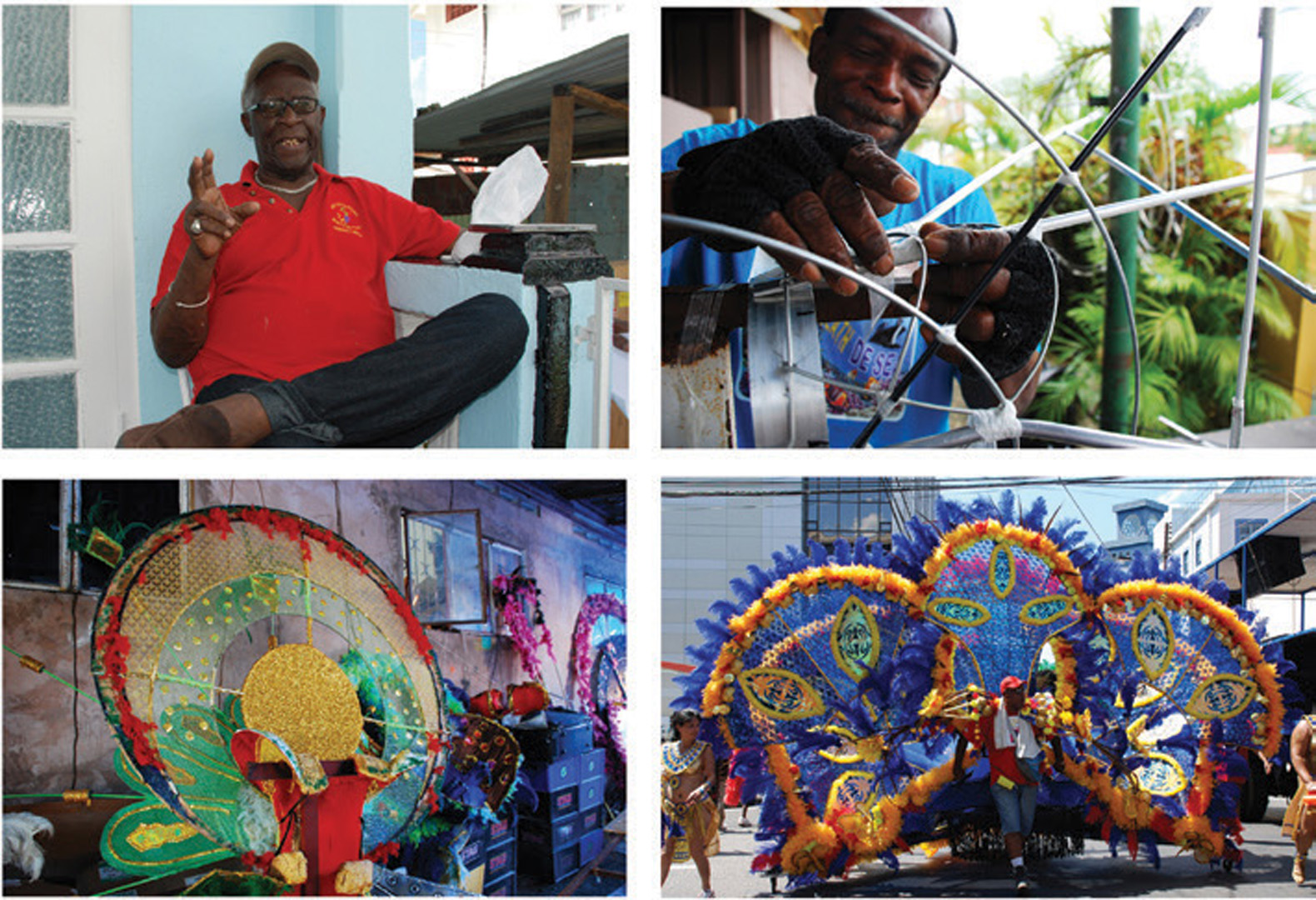“The Bailey-Derek Grammar: Recording the Craft of Wire-Bending in the Trinidad Carnival” by Noel
Conference:
Type(s):
Title:
- The Bailey-Derek Grammar: Recording the Craft of Wire-Bending in the Trinidad Carnival
Presenter(s)/Author(s):
Abstract:
This paper presents work on the development of a shape grammar that records the dying, undocumented craft of wire-bending in the Trinidad Carnival. This craft is important for the building and continuation of cultural heritage and identity. Due to the lack of prior research in this non-Western design practice, the author conducted site visits, interviews and observations, and visually examined wire-bent artifacts in Trinidad to develop this grammar. This paper presents the materials, steps and shape rules that begin to synthesize the craft, as well as one design. This study and the resulting grammar have positive implications for design education and practice.
References:
1. “Lewicito ‘Cito’ Velasquez.” 2015. Accessed April 2, <www.ncctt.org/50years/index.php/110-mas-stuff/17888-lewicito-cito-velasquez>.
2. Bailey, Albert. 2013. Interview by Vernelle Noel. Personal Interview.
3. Crowley, Daniel J. 1956. “The Traditional Masques of Carnival.” Caribbean Quarterly 4 (3/4): 194–223.
4. Noel, Vernelle A.A. 2013. “Trinidad Carnival: Improving Design through Computation and Digital Technology.” Masters Thesis, Cambridge, Mass: Massachusetts Institute of Technology.
5. Stiny, G., and W.J. Mitchell. 1978. “The Palladian Grammar.” Environment and Planning B: Planning and Design 5 (1): 5–18.
6. Reddy, Michael J. 1979. “The Conduit Metaphor: A Case of Frame Conflict in Our Language about Language,” in Metaphor and Thought, 284–97. Cambridge: Cambridge University Press.
7. Knight, Terry. 1999. Applications in Architectural Design, and Education and Practice. Report for the NSF/MIT Workshop on Shape Computation. Massachusetts Institute of Technology, <www.shapegrammar.org/education.pdf>.
8. Brown, Ernest D. 1990. “Carnival, Calypso, and Steelband in Trinidad.” The Black Perspective in Music 18 (1/2): 81–100.
9. Martin, Carol. 1998. “Trinidad Carnival Glossary.” TDR (1988-) 42 (3): 220–235.
10. Powell, Kimberly. 2008. “Drumming against the Quiet: The Sounds of Asian American Identity in an Amorphous Landscape,” Qualitative Inquiry 14 (6): 901–925.
11. Ryan, Selwyn D, and Institute of Social and Economic Research. 1991. “Social and Occupational Stratification in Contemporary Trinidad and Tobago.” Institute of Social and Economic Research, University of the West Indies.
12. Riggio, Milla Cozart. 2004. Carnival: Culture in Action—The Trinidad Experience. New York: Routledge.
13. Jo-Anne Tull. 2005. “Money Matters – Trinidad and Tobago Carnival 2005.” Trinidad and Tobago, <www.academia.edu/326827/_Money_Matters_in_the_Trinidad_Carnival_>.
14. Green, Garth L., and Philip W. Scher. 2007. Trinidad Carnival: The Cultural Politics of a Transnational Festival. Indiana: Indiana University Press.
15. Riggio, Milla Cozart. 2004. Carnival: Culture in Action—The Trinidad Experience. New York: Routledge.
16. Bailey, Albert. 2013. Interview by Vernelle Noel. Phone Interview.
17. Wuest, Ruth. 1990. “The Robber in the Trinidad Carnival.” Caribbean Quarterly 36 (3/4): 42–53.
18. Crowley, Daniel J. 1956. “The Traditional Masques of Carnival.” Caribbean Quarterly 4 (3/4): 194–223.
20. Wuest, Ruth. 1990. “The Robber in the Trinidad Carnival.” Caribbean Quarterly 36 (3/4): 42–53.
21. Derek, Stephen. 2013. Interview by Vernelle Noel. Personal Interview.
22. Mitchell, William J. 1986. “Formal Representations: A Foundation for Computer-Aided Architectural Design,” Environment and Planning B: Planning and Design 13 (2): 133–162.
23. Stiny, G., and W.J. Mitchell. 1978. “The Palladian Grammar.” Environment and Planning B: Planning and Design 5 (1): 5–18.
24. Flemming, U. 1987. “More than the Sum of Parts: The Grammar of Queen Anne Houses,” Environment and Planning B: Planning and Design 14 (3): 323–350.
25. Colakoglu, Birgul. 2005. “Design by Grammar: An Interpretation and Generation of Vernacular Hayat Houses in Contemporary Context,” Environment and Planning B: Planning and Design 32 (1): 141–149.
26. Stiny, George, and James Gips. 1971. “Shape Grammars and the Generative Specification of Painting and Sculpture,” in Sciences & Humanities: Models and Applications for the Arts. Ljubljana, Yugoslavia: North Holland Publishing Co.
27. Knight, T.W. 1989. “Transformations of De Stijl Art: The Paintings of Georges Vantongerloo and Fritz Glarner,” Environment and Planning B: Planning and Design 16 (1): 51–98.
28. Agarwal, M., and J. Cagan. 1998. “A Blend of Different Tastes: The Language of Coffeemakers.” Environment and Planning B: Planning and Design 25 (2): 205–226.
29. Knight, T. Weissman. 1980. “The Generation of Hepplewhite-Style Chair-Back Designs,” Environment and Planning B: Planning and Design 7 (2): 227–238.
30. Personal Interview by Vernelle Noel. 2012.
31. Green, Garth L., and Philip W. Scher. 2007. Trinidad Carnival: The Cultural Politics of a Transnational Festival. Indiana: Indiana University Press.
32. Personal Interview by Vernelle Noel. 2013.
33. Personal Interview by Vernelle Noel. 2013.
34. Personal Interview by Vernelle Noel. 2013.
35. This portion of the process steps (computations) in Figure 3 was selected from a larger group of steps for the focus of this paper.




